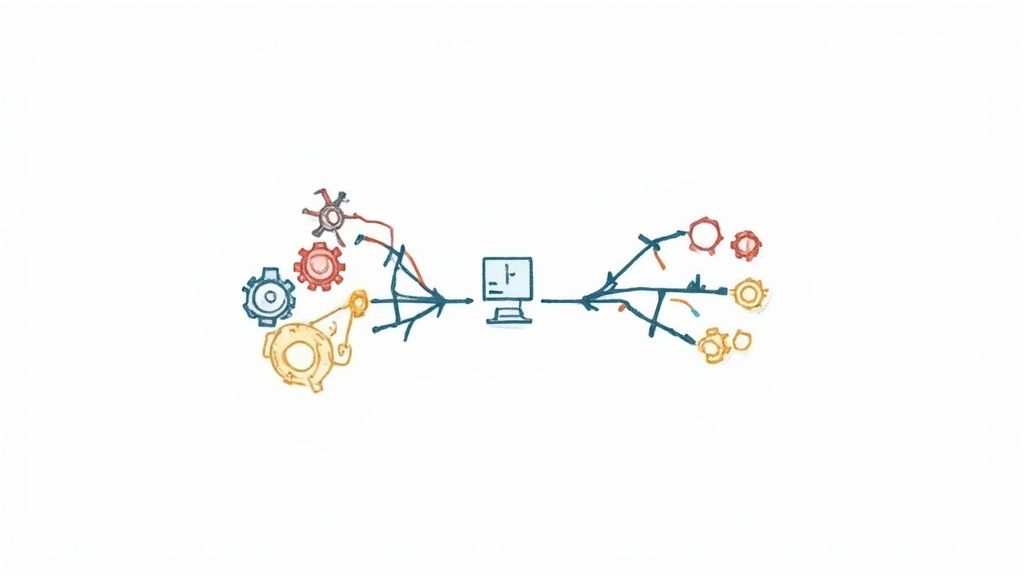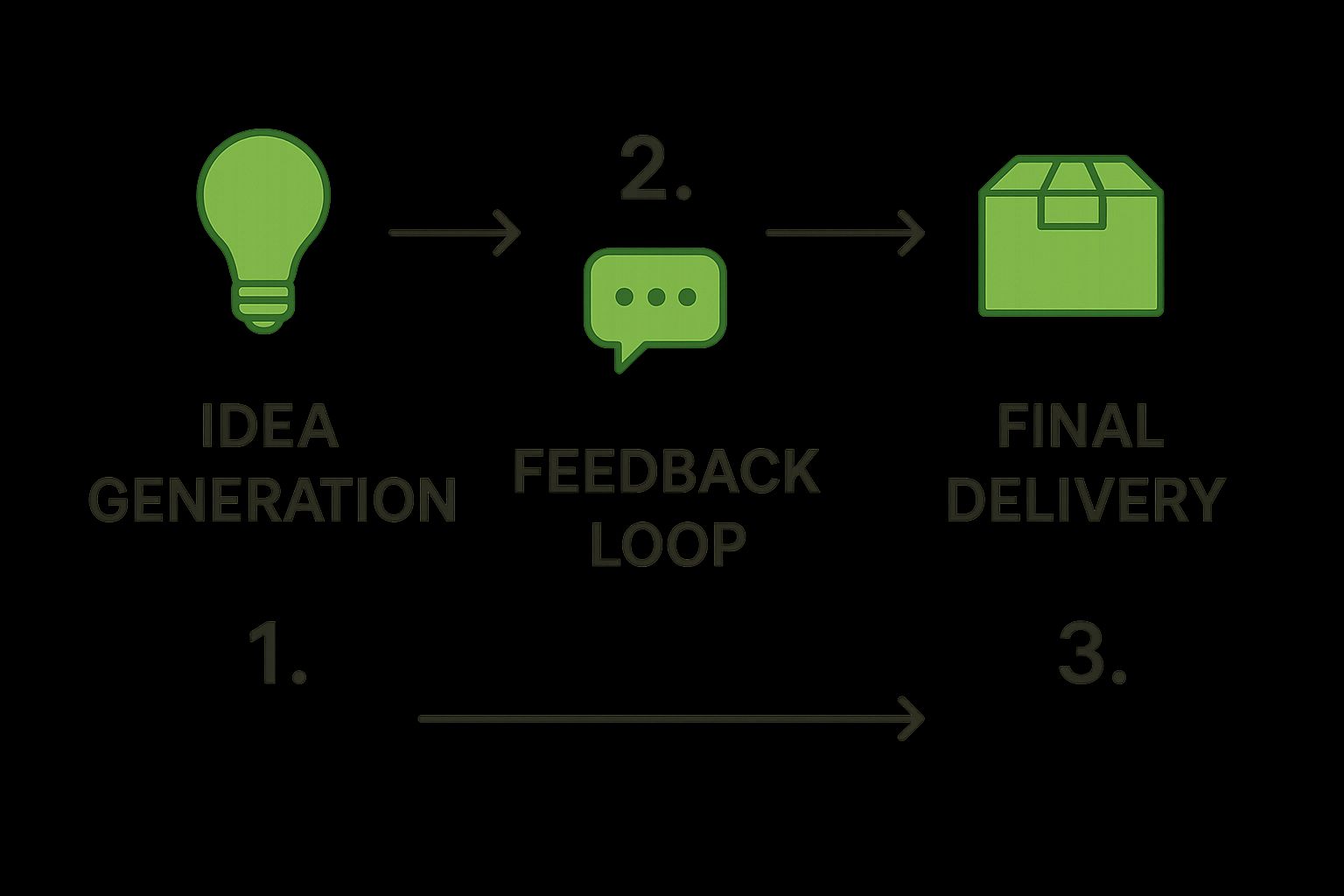A Guide to Creative Operations Management
Ever feel like your creative department is a swirling vortex of last-minute requests, missing files, and endless review cycles? You're not alone. This is precisely where creative operations management steps in.
Think of it less as a rigid set of rules and more as the essential framework that brings order to the beautiful chaos of creative work. It's not just about managing individual projects. It’s about building the entire system—the workflows, tools, and processes—that empowers designers, writers, and artists to do their best work, free from administrative headaches.
The Air Traffic Control for Your Creative Team
Imagine your creative team is a bustling airport. Every brilliant idea is a plane, ready and eager for takeoff. Without a system, it's a disaster waiting to happen. You'd have collisions, frustrating delays, and planes getting lost altogether.
Creative operations management is that air traffic control system. It gives every single project, from a quick social media graphic to a massive campaign launch, a clear and safe flight path from the initial request to the final delivery.
This goes way beyond typical project management, which tends to focus on the timeline and tasks of one project at a time. Creative ops takes a bird's-eye view of the entire creative ecosystem. It's responsible for answering the big, recurring questions:
- How do we standardize project requests so we get all the necessary info right from the start?
- What's the smartest way to route work for review and approval without creating bottlenecks?
- How do we organize our digital assets so anyone can find what they need in seconds, not hours?
- Which tools will actually support our team's unique way of working, instead of forcing them into a box?
To get a clearer picture, let's break down the main responsibilities involved.
Core Functions of Creative Operations Management
The table below outlines the primary responsibilities and objectives that form the foundation of a strong creative operations framework.
| Core Function | Primary Goal |
|---|---|
| Intake & Briefing | To standardize how work is requested and ensure every project starts with a clear, comprehensive brief. |
| Resource Management | To allocate the right people to the right projects, manage workloads, and prevent team burnout. |
| Workflow Optimization | To design, implement, and continuously improve the processes for creating, reviewing, and approving work. |
| Technology & Tools | To select, implement, and manage the software (like DAMs, project management tools, etc.) that supports the creative process. |
| Asset Management | To organize, store, and distribute final creative assets, making them easily accessible for reuse. |
| Performance & Reporting | To track key metrics, measure the team's impact, and provide data-driven insights for improvement. |
Each of these functions works together to create a smooth, predictable, and efficient environment for the creative team.
It’s About Empowering Creativity, Not Restricting It
Ultimately, the goal of creative operations is to build an environment where creativity can truly thrive. When the process is clear and predictable, creatives are liberated. They no longer have to waste precious energy chasing down feedback, digging for lost files, or trying to decipher vague instructions. They can focus on what they do best: creating stunning, impactful work.
The role of the creative operations leader is more critical than ever. In today's market, these pros are juggling bigger workloads with tighter resources, all while trying to make sense of a complex world of new marketing tech and AI tools. As a result, building strong partnerships with other departments to align on goals has become a top priority. A recent report on creative operations priorities shows just how much this role is evolving to meet modern business demands.
The real magic of creative operations is that it builds a well-oiled machine that empowers creativity, not stifles it. It transforms the often unpredictable nature of creative work into a reliable, scalable, and value-driving part of the business.
By putting a solid creative ops strategy in place, companies sidestep common pitfalls like blown deadlines, busted budgets, and team burnout. It’s the strategic backbone that turns brilliant ideas into tangible, measurable results, making sure every ounce of creative effort directly supports the company's goals. This is why it's not just a "nice-to-have" support function—it’s a powerful competitive advantage.
Why Effective Creative Operations Is a Game Changer

Let’s be honest. Without a solid operational backbone, a creative department can feel like a runaway train. You’re constantly dealing with missed deadlines, blown budgets, and a brand message that seems to change with the wind. Sound familiar? This isn't just frustrating; it's a direct hit to your company's bottom line.
This is where effective creative operations management comes in. Think of it as the secret sauce that turns that unpredictable chaos into a well-oiled machine for growth. It’s about moving from a "hope for the best" approach to intentionally engineering great outcomes, every single time.
The change is almost immediate. When your workflows are clear and efficient, campaigns get out the door faster, letting you jump on market trends while your competitors are still in meetings. And this speed doesn't mean you sacrifice quality—quite the opposite, it actually improves it.
Turning Chaos Into a Competitive Advantage
A well-run creative operations system tackles the nagging problems that hold creative teams back, transforming those weaknesses into genuine strengths. Instead of constantly putting out fires, your team can finally focus on creating amazing work.
Here’s what that transformation looks like:
- From Budget Overruns to High ROI: With a firm grip on resources and timelines, you ensure every penny spent on creative work delivers real, measurable value.
- From Inconsistent Messaging to Strong Brand Governance: Clear review and approval processes mean every asset—from a quick social post to a major ad campaign—is perfectly on-brand.
- From Creative Burnout to Engaged Teams: By removing the administrative headache, creatives can get back to doing what they love. This boosts morale, cuts down on turnover, and fuels more imaginative work.
In the end, strong creative operations management stops creative potential from going to waste. It makes sure brilliant ideas don't just stay on the whiteboard but are executed flawlessly—on time and on budget—to drive results you can see.
More Than a Cost Center—It’s a Value Driver
Too many companies see creative ops as just another line item on the budget, an administrative chore. This view completely misses the point. When you get it right, creative operations becomes a powerful engine for value and a major competitive edge.
For instance, by organizing the content delivery pipeline, a business can dramatically scale its marketing without having to hire a proportionally larger team. A structured system empowers your people to produce more high-quality work in less time. This efficiency also frees up your designers, writers, and artists from mind-numbing admin tasks, letting their creativity shine.
This kind of operational excellence turns your creative team from a reactive service desk into a proactive partner in hitting your business goals. It’s proof that investing in your process is one of the smartest ways to amplify your talent and get a bigger return on your best ideas.
Meet the People Who Power the Process

While systems and software get a lot of attention, creative operations management is, at its heart, all about people. It takes a specific set of roles to connect a great creative idea with real-world business results. These individuals are the ones who build and maintain the entire creative engine, making sure everything runs smoothly.
A film crew analogy works perfectly here. You have a director with the vision, a producer handling the logistics, and a crew executing the day-to-day work. Creative ops teams have a similar structure to ensure projects are not just brilliant, but also delivered on time and on budget.
The success of creative operations doesn't just hinge on having the right tools; it depends on having the right people in the right seats, each with a clear purpose and set of responsibilities.
Let’s take a look at the key players who make the magic happen.
The Creative Operations Director
Sitting at the top is the Creative Operations Director. This person is the strategic brain of the department, focused on designing the entire operational ecosystem rather than getting lost in the weeds of daily tasks. Think of them as the chief architect of how creative work gets done.
Their main responsibilities include:
- System Design: Building the high-level workflows, processes, and standards that guide the whole creative team.
- Strategic Alignment: Making sure the team's output and capabilities match up with the company's bigger goals.
- Technology Strategy: Choosing the right tools for the job, from project management software to Digital Asset Management (DAM) systems.
- Budgeting and Forecasting: Managing the department’s budget and planning for future needs based on where the business is headed.
The Director essentially builds the playground, setting up the structure that allows the team to be efficient and scale their work.
The Creative Operations Manager
If the Director is the architect, the Creative Operations Manager is the general contractor who brings the blueprints to life. This role is all about putting the Director's systems into practice and making them better over time. They are the on-the-ground problem-solvers, clearing roadblocks so the creative team can focus on creating.
Managers get deep into process refinement, making sure a workflow that looks good on paper actually works in the real world. They keep an eye on project health, juggle resources to prevent burnout, and act as the bridge between creatives and other stakeholders. Their job is to make the entire process hum.
The Creative Operations Coordinator
Down in the trenches, the Creative Operations Coordinator is the operational linchpin. They handle the daily logistics that keep individual projects chugging along. This is the most hands-on role, focused on pure execution within the established system.
A Coordinator’s day might include scheduling kickoff meetings, tracking project status against deadlines, and managing the queue of incoming creative requests. They are the ones who make sure the machine is running smoothly, day in and day out.
Together, these roles—from the strategic Director to the hands-on Coordinator—blend operational savvy with a deep respect for the creative process. It's this coordinated effort that helps teams navigate the complexities of modern creative work. You can learn more about how these roles are making creative work that matters and building successful teams.
Building Your Creative Workflow Engine
Think of your creative operations strategy as a high-performance car. To get anywhere, you need a powerful engine. In the world of creative work, that engine is your workflow—the system that moves every project from a spark of an idea to a finished product. This isn't about boxing in creativity with rigid rules. It's about building a clear, repeatable roadmap that eliminates chaos and keeps everyone on the team heading in the same direction.
Building this engine means mapping out the entire journey of a creative project, one crucial process at a time.
The Right Start: Intake And Briefing
Every project has a beginning, and this is where most of them go off the rails. The first and most important stage is Intake and Briefing. Without a consistent way to handle incoming requests, your team is stuck trying to make sense of vague emails, chasing stakeholders for key details, and wasting precious time before a single creative task can even start.
A structured intake process is your first line of defense against that chaos. It simply means that every project kicks off with the clarity it needs to succeed, usually through a standardized creative brief form that captures all the essential information right from the get-go.
Ever feel like you're speaking a different language than your stakeholders? You're not alone. While 94% of stakeholders are confident they provide clear direction, a mere 69% of creatives feel the same way. That’s a huge 25% gap in understanding. This single statistic shows exactly why a formal briefing process is so essential—it bridges that communication divide.
This flow chart shows how a great idea can move smoothly through a system, with feedback fueling progress instead of stalling it.

As you can see, a healthy workflow isn't just a straight line from A to B. It's a cycle, with built-in feedback loops that help refine and improve the work at every important step.
Getting It Done: Workflow And Approval Cycles
Once a project is properly briefed and assigned, it moves into the Workflow and Production phase. This is the "get it done" stage where the actual creative magic happens. To keep things from going sideways, it’s vital to map out every step of the journey, from the first draft to the final, polished version. For instance, understanding all the steps in something specific like the logo design process can give you a great blueprint for structuring your other creative workflows.
Tied directly to production are the Review and Approval Cycles. This is where things often grind to a halt. We’ve all been there—feedback comes in late, from too many people at once, or in a format that's more confusing than helpful.
An effective review cycle isn't about getting a simple "yes" or "no." It's a structured conversation designed to gather specific, actionable feedback that moves the project forward, not backward.
To fix this common bottleneck, you need to clearly define who reviews the work, when they review it, and how they should give their feedback. A well-designed workflow approval process can slash delays and cut down on frustration for everyone involved.
Finally, after all that hard work gets the green light, Asset Management takes over. This last step ensures the final files are properly organized, tagged, and stored so they can be easily found and reused later, protecting their value long after the campaign is over.
7 Best Practices for High-Performing Creative Teams

Turning your creative operations from good to truly great doesn't happen overnight. You don't need a massive, disruptive overhaul. Instead, real success comes from building a series of smart, focused habits. By adopting these proven practices, you can create a system that not only runs smoothly but also frees up your team to do their best, most innovative work.
The whole point is to build a predictable environment that supports creativity, rather than accidentally stifling it. It all starts by systemizing the repetitive stuff so your team can save their mental energy for the work that actually matters.
1. Standardize and Centralize Your Workflows
One of the quickest wins you can get in creative operations is standardization. This simply means creating and using templates for your most common projects, creative briefs, and reports. Templates create consistency and, more importantly, save everyone from reinventing the wheel with every new request. Think of them as the foundation of an efficient workflow.
Just as important is centralizing where work conversations happen. When discussions are scattered across emails, DMs, and random meetings, critical information inevitably gets lost. A single, central hub for all project communication and feedback is a non-negotiable.
Key Takeaway: Standardization and centralization aren't about restricting creativity. They're about creating a clear, easy-to-follow path so your creative team can focus on innovation instead of administrative busywork.
This simple shift directly tackles the bottlenecks that drain resources and cause so much frustration.
2. Embrace Data and Never Stop Improving
If you want to truly fine-tune your creative operations, you have to treat it like a living system—one that needs regular check-ups. This is where data becomes your most valuable tool. Start by tracking a few key metrics to get a real picture of how your team is performing.
Focus on simple but powerful metrics like:
- Project turnaround time: How long do different project types really take from start to finish?
- Number of revision cycles: How many rounds of feedback does a typical project go through?
- Resource utilization: Are some team members consistently overloaded while others have bandwidth?
This data isn't for micromanaging. It's for spotting patterns and pinpointing real opportunities for improvement. Creative operations can benefit hugely from established business process improvement methods that help you adapt and evolve.
Building a culture where processes are regularly reviewed and tweaked is essential for long-term success. Small, iterative changes add up to huge gains in efficiency and output over time. For more ideas, check out our guide on how to improve team productivity for some extra strategies.
How to Choose Your Creative Operations Toolkit
Picking the right software for your creative operations isn't about finding one magical tool that does everything. It’s more like building a custom toolkit. What works for a nimble five-person agency will be completely different from what a sprawling enterprise marketing department needs.
The secret is to figure out what you actually need before you start getting wowed by fancy features. Think about your biggest bottlenecks. Are you constantly chasing deadlines and losing track of project status? Then a solid project management tool is your starting point. If your team spends more time searching for the right logo file than actually creating, a Digital Asset Management (DAM) system should be your top priority.
Assess Your Core Needs
To avoid getting overwhelmed, start by asking a few practical questions:
- Team Size and Complexity: How many people need access? A small team of five can get by with simpler, more direct tools. But a department of 50 will need sophisticated user permissions, detailed reporting, and clear approval workflows to prevent chaos.
- Integration Capabilities: Your new tools have to play nice with the software you already use every day. Make sure they can connect to your team's chat app, cloud storage, and, most importantly, your design programs.
- Primary Function: What is the single biggest headache you want to solve? Is it managing the chaotic flood of new creative requests? Is it the endless back-and-forth of the review and approval cycle? Pinpoint that main source of friction and let it guide your search.
For a lot of teams, the most effective approach is to find a comprehensive platform that brings multiple functions under one roof. Juggling half a dozen different subscriptions is not only expensive but also a surefire way to create information silos.
A platform like Publora is built specifically to handle the entire creative lifecycle. It consolidates everything from brainstorming and AI-assisted content creation all the way through to scheduling and publishing. This means your team can stay in one cohesive environment.
Having a single dashboard gives you a bird's-eye view of your entire content pipeline. You can manage social media posts, blog articles, and campaign assets without constantly toggling between different tabs and logins. It also makes it easier to experiment with new technologies, like the best AI art generator tools, and integrate them into your established workflow.
Choosing your toolkit is a strategic decision that directly impacts your team's efficiency and creative output. The goal is to find a solution that removes friction, not one that adds another layer of complexity to your process.
At the end of the day, whether you need a simple content scheduler or a full-fledged creative operations suite, the right choice empowers your team to do what they do best: create amazing work.
If your focus is primarily on social media, our guide to social media management tools offers some more tailored recommendations.
Your Top Creative Operations Questions, Answered
As teams start dipping their toes into the world of creative operations, a few questions always seem to pop up. It’s totally normal. Getting these sorted out is the first step to feeling confident enough to bring these ideas back to your own team.
Let's walk through some of the most common ones.
Is Creative Operations Just a Fancier Name for Project Management?
This is easily the most common question, and it's a great one. The short answer is no, they're quite different.
Project management is all about the specifics of a single project. Think timelines, tasks, budgets, and getting that one thing across the finish line. It’s tactical and focused.
Creative operations management is the bigger picture. It's about designing the entire system—the workflows, the tech stack, the team roles—that makes all creative work possible and predictable. It’s the strategic foundation.
Here's an analogy I like: If project management is the chef cooking a specific meal, creative operations is the person who designed the entire kitchen, from the layout and appliances to the process for ordering ingredients.
How Can a Small Team Even Start with Creative Ops? We Don't Have the Resources!
You don't need a massive team or a six-figure budget to get started. In fact, starting small is the best way to do it. The trick is to identify your single biggest headache and fix that first.
For most small teams, the biggest mess is the project request process. Someone sends a Slack message, another sends an email with half the details, and a third just grabs you in the hallway. Sound familiar?
- Start with a simple intake form. Use a free tool like Google Forms or Airtable to create a standardized request brief. This forces everyone to provide the same key information upfront.
- Get a basic workflow board. Tools like Trello or Asana have fantastic free plans. Just creating a simple "To Do," "In Progress," and "Done" board brings immediate clarity.
The goal isn't to boil the ocean. It's about bringing a little bit of order to the chaos, one process at a time. Once you prove the value there, you'll have the momentum to tackle the next challenge.
Ready to stop the chaos and start creating more efficiently? Publora centralizes your entire content workflow, from planning and AI-assisted creation to scheduling and publishing, all from a single dashboard. Take control of your creative process by visiting https://publora.com to start your free trial.
